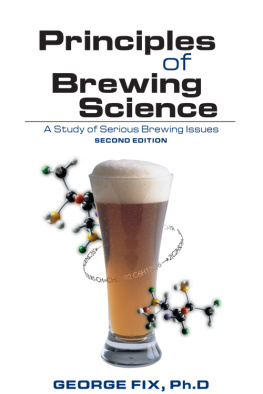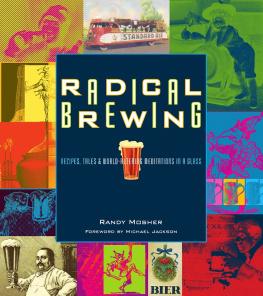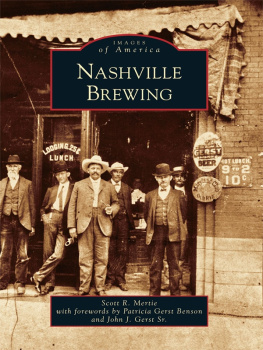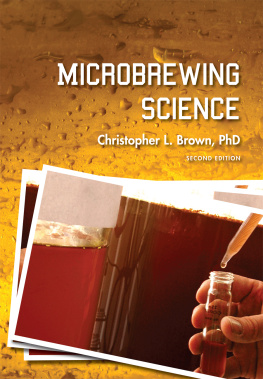Fix - Principles of brewing science: a study of serious brewing issues
Here you can read online Fix - Principles of brewing science: a study of serious brewing issues full text of the book (entire story) in english for free. Download pdf and epub, get meaning, cover and reviews about this ebook. City: Boulder;Colo, year: 1999;2015, publisher: Brewers Publications, genre: Children. Description of the work, (preface) as well as reviews are available. Best literature library LitArk.com created for fans of good reading and offers a wide selection of genres:
Romance novel
Science fiction
Adventure
Detective
Science
History
Home and family
Prose
Art
Politics
Computer
Non-fiction
Religion
Business
Children
Humor
Choose a favorite category and find really read worthwhile books. Enjoy immersion in the world of imagination, feel the emotions of the characters or learn something new for yourself, make an fascinating discovery.
Principles of brewing science: a study of serious brewing issues: summary, description and annotation
We offer to read an annotation, description, summary or preface (depends on what the author of the book "Principles of brewing science: a study of serious brewing issues" wrote himself). If you haven't found the necessary information about the book — write in the comments, we will try to find it.
Fix: author's other books
Who wrote Principles of brewing science: a study of serious brewing issues? Find out the surname, the name of the author of the book and a list of all author's works by series.
Principles of brewing science: a study of serious brewing issues — read online for free the complete book (whole text) full work
Below is the text of the book, divided by pages. System saving the place of the last page read, allows you to conveniently read the book "Principles of brewing science: a study of serious brewing issues" online for free, without having to search again every time where you left off. Put a bookmark, and you can go to the page where you finished reading at any time.
Font size:
Interval:
Bookmark:
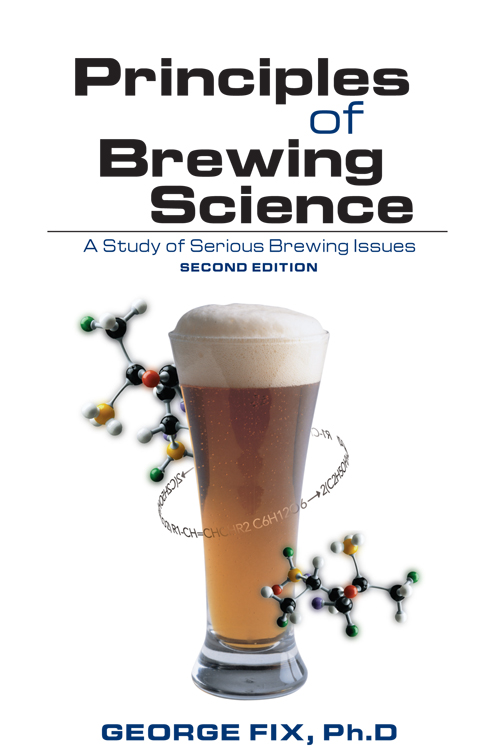
GEORGE FIX, Ph. D.
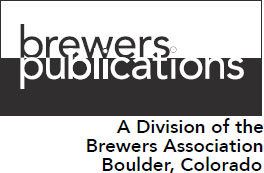
Brewers Publications
A Division of the Brewers Association
PO Box 1679, Boulder CO 80306-1679
Tel: 303-447-0816 Fax: 303-447-2825
BrewersAssociation.org
1999 by George J. Fix
All rights reserved. No portion of this book may be reproduced in any form without written permission of the publisher. Neither the author, editor, nor the publisher assume any responsibility for the use or misuse of information contained in this book.
ISBN-13: 978-0-937381-74-8
ISBN-10: 0-937381-74-8
EISBN: 978-1-938469-19-0
Library of Congress Cataloging-in-Publication Data
Fix, George J., 1939
Principles of brewing science : a study of serious brewing issues
George Fix. 2nd ed.
p. cm.
Includes .
ISBN 0-937381-74-8 (pbk.)
1. Brewing. I. Title
TP570.F58 1999
663.3dc21
99-36534
CIP
Many people have contributed to the production of this book. Foremost is my wife, Laurie Ann Fix. She is my companion, confidant, best friend, and love of my life. Without her, nothing would have been possible.
I am also grateful for the significant input of Scott Bickman, a technical reviewer of this book. Dr. Bickman is a scienist of accomplishment and depth. He also has a striking ability to distinguish between issues that are crucial in brewing from those which are merely theoretically possible. I would also like to acknowledge the many comments, corrections, and abservations made by Dr. Rick Wood. In fact, the contributions of Drs. Bickman and Wood were integral to the completion of this book. Nevertheless, I take full responsibility for any problems associated with the material in this book.
The late Gilbert Straub was my brewing mentor, and his Weltweisheit of brewing guides me to this very day. Under his leadership, the tiny Straub Company sailed through the post- World War II era at full capacity, while other small operations were closing. Even in the early 1980s when his was only one of three commercial breweries with a capacity under 25,000 bbls., it was clear that the Straub Brewing Company was going to be around for the long haul. There is a lesson for small commercial breweries in this history.
I am also grateful to Brewers Publications and my publisher Toni Knapp, for guidance in the preparation of this book. The technical editor, Mary Eberle, made significant and important contributions to the accuracy of the material. This book could never have been published without their editorial management.
Finally, I would like to cite all the brewers, who are too numerous to mention, including those who have participated on the Professional Tasting Panel of the Great American Beer Festival, members of the MBAA and ASBC, and the remarkable and stimulating discussions that take place at the meetings and conferences. Also to be acknowledged is an even longer list of homebrewers. Over the years homebrewing conferences, competitions, and electronic forums like Homebrewers Digest have added greatly to my understanding of brewing.
The great Viennese composer, Anton Webern (1883-1945), once remarked, All art, all music is based on laws (Bailey, 1998). Webern was not denying creativity and originality. Indeed, he was one of the twentieth centurys most innovative musical figures. Rather, he saw fundamental principles as a guide to lead him down the path to the new music he wanted to write, and to understanding the past masters he so revered.
Brewers are in a remarkably similar situation. Creativity and originality are shared values for all of us. What separates this highly heterogeneous group are our objectives. This, too, has an analogy in music. For example, the only thing Webern and Johann Strauss appear to have had in common was that their major works were composed in or near Vienna. Strauss sought popular success, and Webern artistic success. Yet both used the same principles of harmony and counterpoint, albeit in radically different ways! Put differently, things happen for a reason, and fundamental laws are our best guide to understanding the consequences of our actions.
The intriguing situation about brewing, on the other hand, is that many mechanisms are theoretically possible, and the real key to success is the ability to identify those that are genuinely relevant in any particular situation.
I would like to identify what I feel is a rank ordering of material in terms of relevance. Relevance in brewing exists on three levelsprimary, secondary, and tertiary. Primary effects are crucial, and every serious brewer needs to completely master these. Dealing with secondary and tertiary effects amounts to varying degrees of fine tuning.
Fermentation. As long as beer flavor is the final arbiter of what is desirable, the fermentation of beer will be the area in brewing of greatest practical importance. Moreover, this is as true for conventional beers brewed with conventional techniques as it is for specialty beers.
A mastery of the various metabolic pathways is highly recommended for even beginning brewers. The major pathway, often called the Embden-Meyerhof-Parras pathway, consists of Glycolysis, where each molecule of glucose is transformed to two molecules of ethanol and two molecules of carbon dioxide. A strong case can be made that the first part of this pathway is the most crucial. It is certainly the part of the fermentation where we as brewers can exert the greatest control. In this regard, consider the following four points.
First, the yeast used must be in excellent physiological condition. The yeast membrane controls what enters and leaves the yeast cell, and its viability is a necessary condition for a satisfactory start of the fermentation. Also important is for the yeast to have an adequate food supply within their cells.
The second and closely related issue is to add an adequate number of yeast cells. At the start of the fermentation more yeast is definitely better than less, however, too much is not good either. Indeed, one of the major themes that permeate this book is that successful brewing is one where the correct balance is struck in all issues. Fortunately, there are elementary procedures for measuring viability food reserves and cell counts.
The third point associated with the initial period is the indispensable role that oxygenation of chilled wort plays as a yeast nutrient. The most important aspect of exogenous oxygen is associated with yeast synthesis of sterols and unsaturated fatty acids, a crucial step in the maintenance of yeast viability. Yet there is more, and the inevitable conclusion one reaches is that wort oxygenation can never be omitted by quality conscious brewers.
The fourth and final point about the start of the fermentation relates to wort composition, and the vital role played by key wort constituents such as nitrogen from amino acids.
Other parts of beer fermentation that fall into the primary relevance category are the various minor metabolic pathways. These produce such flavor active products as esters, fusel alcohols, diacetyl, and phenols, to cite a few examples. The term minor is used for these pathways because only a miniscule amount of products are produced in them, typically less than 1 mg per liter. This is in striking contrast to the main pathway where over 40,000 mg per liter of ethanol is produced in beers of normal strength. Yet, what I find most fascinating about brewing is that minor products can influence beers flavors in ways that far exceed their concentrations. Put differently, the minor pathways can become major once the quality of beer flavor is put on the table.
Font size:
Interval:
Bookmark:
Similar books «Principles of brewing science: a study of serious brewing issues»
Look at similar books to Principles of brewing science: a study of serious brewing issues. We have selected literature similar in name and meaning in the hope of providing readers with more options to find new, interesting, not yet read works.
Discussion, reviews of the book Principles of brewing science: a study of serious brewing issues and just readers' own opinions. Leave your comments, write what you think about the work, its meaning or the main characters. Specify what exactly you liked and what you didn't like, and why you think so.

